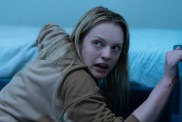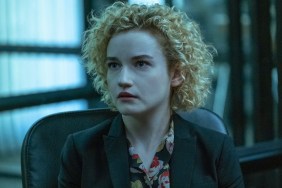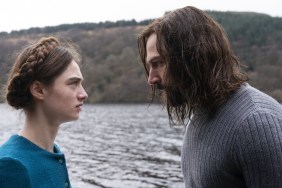
8 out of 10
The Keeping Room Cast
Brit Marling as Augusta
Hailee Steinfeld as Louise
Sam Worthington as Moses
Muna Otaru as Mad
Kyle Soller as Henry
Ned Dennehy as Caleb
Amy Nuttall as Moll
Nicholas Pinnock as Bill
Anna-Maria Nabirye as Alma
Luminita Filimon as Prudence
Review
A woman walks heavy down a desolate dirt road, kicking up bits of the ground as she carries supplies back home on this long, hot trek. Suddenly, an angry black dog appears in front of her, snarling and growling and bearing its teeth, as if to send out a verbal cue of her soon-to-be demise. Just when it seems that all hope is lost for this lone little stranger, the girl reveals her own ferocious set of jaws, and barks back at her four-legged predator, surprising even the dog, who seems momentarily taken aback. As the two face off in a showdown of intimidation, the woman appearing more wild with each utterance, as she speaks in a language preserved for beasts, it becomes clear that this feral attitude is a trait that amplified during the brutality of the 1800s, when women were forced to exhibit raw strength and fearless determination in the face of terror, thus forever changing the women who sought to survive such wicked battles, and see it through to the end of the brief but bloody American Civil War.
Augusta, Louise, and Mad all reside together as not only the only women, but also as the only occupants of their remote southern farmhouse. With the mother of the house passed away, and the brother and father off fighting for the Confederacy, these ladies do much more than don pretty dresses and aspire to marry into dignified families; they tend to the fields, hunt down rabbits in the woods, and protect one another when the nights grow cold and the shadows in the darkness turn fearsome. In this new, tougher world without men around to depend on, the women of the south are forced to shed their femininity in favor of a more basic primal nature, in order to compete with the ragged stragglers that take advantage of the chaos of war and prey on the weak.
At first, it seems that the three women are carrying on somewhat smoothly without the aid of their male companions. Petty arguments surface as a way of avoiding deeper underlying issues, but the three still manage to work together well enough to put food on the table and feast together peacefully. Their situation is not ideal, but it’s bearable. That is, until Louise is bitten by a raccoon. Due to the less advanced time period and dwindling medical supplies, Augusta is forced to make the trip on horseback into the city, where she catches the eye of a dangerous rogue Union soldier and his sleazy friend. When the two men decide to follow Augusta back home and lay claim on her land and all those who reside within it, it’s up to these three women to defend their home, and their bodies from the domineering, tainted soldiers knocking at their door, demanding to be let in.
Even the best westerns often stick to the tired-but-true clichés of a lone cowboy on a quest of revenge, or out to complete a heist. The women in most of these films are typically damsels in distress that need to be rescued, or bar maidens, or victims of assault; thereby initiating the tale of vengeance. These standard static female characters are all but absent in The Keeping Room, which takes the usual formula and flips it on its head by naming three women as its leads, and putting them in a position where they’re forced to fight bravely for their own lives, relying only on the strength of one another, and the gunpowder in their rifles. In a plot that more closely resembles Straw Dogs than The Good, the Bad, and the Ugly, these ladies go up against the threat of invasion, their opponents; trained soldiers, their battle ground; their home, their property; their own bodies. The victor of this battle will not only lay claim to the spoils of this house, but to the women themselves, and seeing these girls fight for the right to their own blood is incredibly moving and empowering. Writer Julia Hart and director Daniel Barber have projected one of the manliest genres of film through a feminine scope, all while retaining all of the grit that’s required when depicting the old west.
Not only does The Keeping Room provide a different perspective than what people typically see in a western, but it also sheds light on the impact that the Civil War made on those who weren’t stationed on the battlefields. Augusta, Louise, and Mad lived very different lives before the war started. Sisters Augusta and Louise mainly concerned themselves with looking as beautiful as possible in order to attract a suitor, and may have occasionally lent a hand in work that was contained within the home, so as not to dirty their pretty dresses. Now, they tend to the fields, chop wood, hunt down prey with a loaded firearm, and ride on horseback into dangerous territory to retrieve much-needed medicine, because they know that there simply is no other option than to abandon all that they know, and rise to the occasion. In a way, despite its grievances, the challenges that this war created managed to change these women for the better by forcing them to be stronger and more self-sufficient. Like all wars, this one brought with it a shift in the balance of power, not only on the front lines, but back at home, too. World War II may be famous for women filling in men’s jobs at the factories, but this film shows how women took on mens’ roles during wartime long before then, even way back in 1861.
Also highlighted is the power shifting between Anglos and African Americans that occurred in the south before the war even ended. With the men of the house off fighting for their country, the amount of daily field work required calls for Augusta and Louise to join in on the chores, thus putting them side by side with their slave girl Mad, who finds it more and more acceptable to speak her mind and finally acknowledge herself as an equal to the white women that share her home. Although Louise may occasionally backslide and exhibit racist behavior and spit out venomous dialogue, she realizes her words can’t change what is happening to her, and winds up digging in the dirt with the same woman that she dare look down on. As Augusta, the older sister, slides into the position of leader of the house, she quickly learns to put such petty differences as skin tone aside, and treat Mad as what she is: a welcome addition to their family. The way the three women bond is very touching, and makes it all the more emotionally riveting when they team up to take down their intruders.
Cinematographer Martin Ruhe beautifully captures the fear and isolation of the Wild West, as well as the anxiety and uncertainty of war. With frames that act as stand alone paintings, and a revolutionary story lead by strong women, The Keeping Room is both appropriate for its time period, and relatable in a modern way. Hopefully, this film will kick start a new era, one where women in westerns can be more than just the bar maidens, or the damsels, or the victims. Maybe now, we’ll see more female gunslingers, or strong silent types, or bandits, or even as the drunken fool who mistakenly challenges a stranger in a saloon to a duel and loses. The point isn’t to always make women look indestructible, more importantly, it’s to represent them in more diverse roles, and The Keeping Room understands and displays this notion accordingly. Although this feminist western could have benefited from a more action-packed final showdown, overall, the film is a giant leap forward in the right direction, and an exciting glimpse into the future of cinema and its betrayal of the old west.









